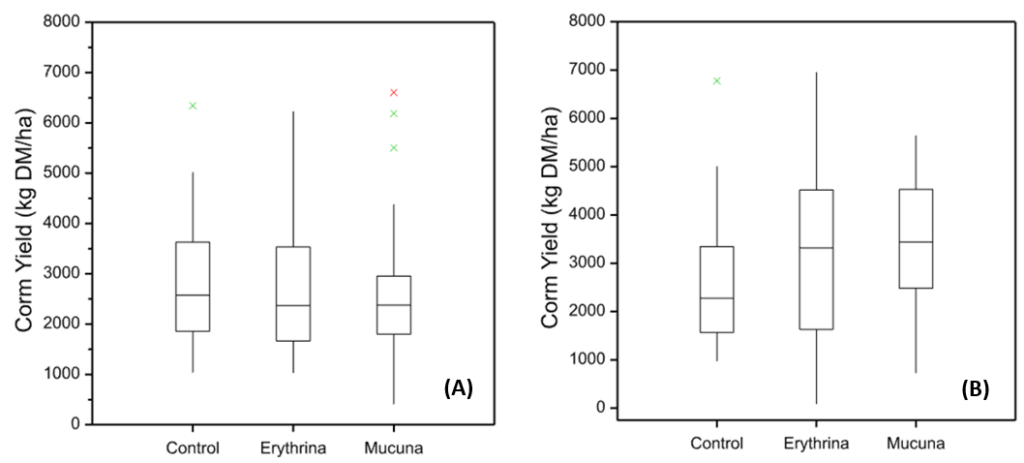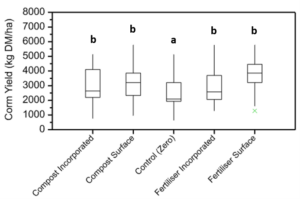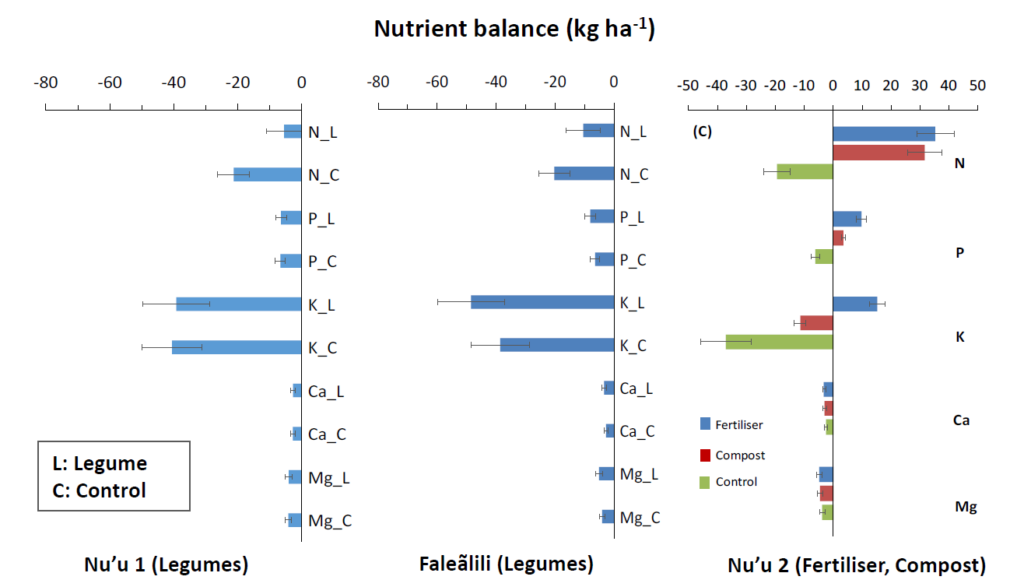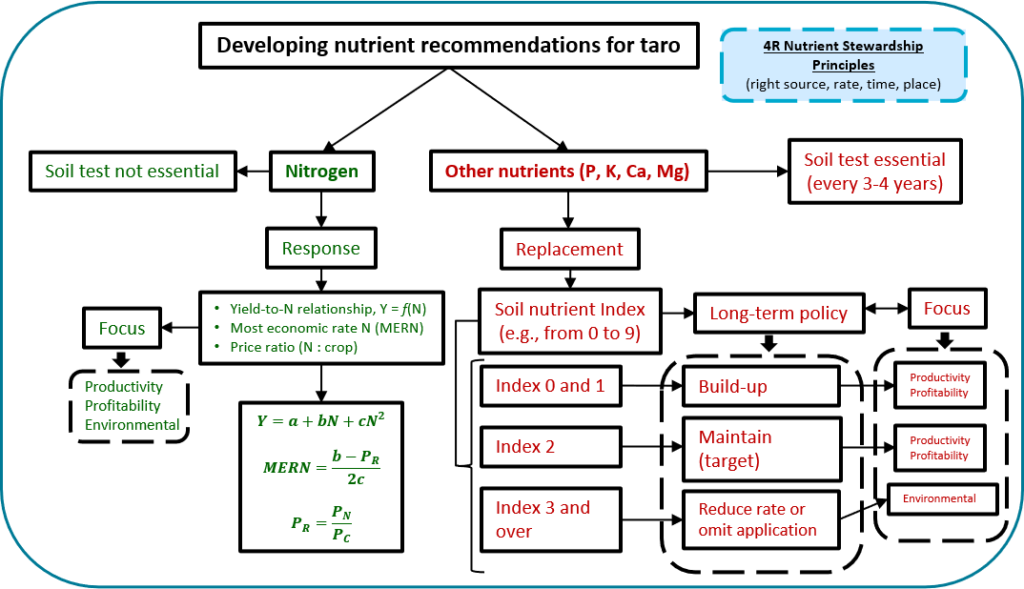 Key results
Key results
Biggest achievements
- Improved understanding of the use of Hanna soil test kits, which are convenient and suitable for use on the farm and with farmers.
- Three field trials at two locations were successfully completed, which made it possible to estimate yield gaps and quantify the soil nutrient balance in taro production systems.
- A conceptual framework for managing soil fertility and formulating nutrient recommendations for taro production systems was developed.
- Research findings and implications were communicated to government agencies, the scientific community, and local growers, extension officers, and agronomists.
Field trials
In Samoa, three field trials (two at the Crop Development Station of the Samoan Ministry of Agriculture at Nu’u and one at a commercial farm in Faleãlili in southern Upolu) were conducted over two cropping seasons (2018-2019 and 2020-2021). In 2018-2019, trials at the sites Nu’u 1 and Faleãlili assessed the efficacy of different species of legumes to supply nitrogen to taro crops as a strategy to reduce the reliance on applied soil organic or inorganic amendments. In 2020-2021, a trial was undertaken at the site Nu’u 2, where the treatments included the addition of NPK+S fertiliser or compost derived from poultry manure. Due to COVID-19 travel restrictions, the team from the Scientific Research Organisation of Samoa ran the field trials largely independently.
Nu’u 1 and Faleãlili sites (2018-2019)
-

Figure 1: Taro corm yield for the field trials at the Nu’u 1 (A) and Faleãlili (B) sites in 2018-2019 in Samoa.
There was no significant difference in taro corm yield between the treatments that used different species of legumes as a source of nitrogen at either the Nu’u or Faleãlili site (Figure 1).
- The amount of nitrogen supplied via fixation was insufficient to meet taro crop demand for nitrogen. Temporary immobilisation of phosphorus in legume biomass is likely to be significant and may therefore reduce its availability to the taro crop during the growing season. This can compromise nitrogen and potassium uptake, and affect crop water-use; particularly, when taro is grown in low fertility soils.
- When legumes are intercropped with taro, the fertilisation program should account for the demand for nutrients of both crops.

Figure 2: Taro yield for four treatments and control for the field trial at the Nu’u 2 site in 2020-2021 in Samoa.
Nu’u 2 site (2020-2021)
- Corm yields for all treatments were significantly higher than the control, however, there was no effect of amendment type (fertiliser vs. compost) or placement (surface application vs. soil incorporation) (Figure 2).
Key field trial findings
Soil properties
- Evidence of significant rundown in soil organic carbon, soil extractable phosphorus and exchangeable potassium, and reduced soil pH as a result of (low-input) cropping.
- Short-term changes (2 cropping seasons) in soil chemical properties were not significant.
Legume intercropping
- Nitrogen supply via fixation in year 1 (establishment) does not meet taro demand for nitrogen.
- Legume crops impact on the phosphorous, potassium and water-use and availability to subsequent taro crops, particularly in low fertility soils.
- Nutrient/fertiliser management plan should account for nutrient demand of both taro and legume.

Figure 3: Nutrient balance for the treatments in the field trials at the Nu’u 1, Faleãlili, and Nu’u 2 sites in Samoa.
Agronomic performance
- Yield gaps can be narrowed by developing and implementing appropriate nutrient management plans, and through improved crop husbandry (weed control).
- Yields recorded with either compost or fertiliser application were higher than with legumes.
Nutrient balance
Nutrient budgets were calculated for the three field trials in Samoa. There was a negative nutrient balance for the trials at the Nu’u 1 and Faleãlili sites (2018-2019) that used different species of legumes as a source of nitrogen (Figure 3). The nutrient balance for the Nu’u 2 site was positive or negative depending on the nutrient and treatment. For the fertiliser and compost treatments, there was a positive nutrient balance for nitrogen and phosphorous and negative balance for calcium and magnesium. However, for the control, there was a negative balance for all nutrients. Apparent surpluses of nitrogen, phosphorus and potassium at the Nu’u 2 site were explained by poor use efficiency of applied nutrients due to lack of appropriate weed control.
Towards improved nutrient recommendations for taro

Figure 4: Conceptual framework to support the development of nutrient recommendations for taro production systems. The yield-to-nitrogen response assumes a quadratic-plateau relationship where: Y is yield, N is nitrogen application rate, and a, b and c are regression coefficients; MERN is the most economic rate of nitrogen and can be derived directly from the nitrogen response curve; and PR, PN and PC are price ratio, price of nitrogen and price of crop, respectively. The numerical scale used to define soil nutrient Index (from 0 to 9) is given as example and it may be modified to suit specific requirements. The 4R Nutrient Stewardship Principles must be always observed.
This framework proposes that recommendations for nitrogen be derived from the yield-to-nitrogen response function and that for other nutrients (phosphorus, potassium, calcium, and magnesium) recommendations be based on replacement (Figure 4). Knowledge of the yield-to-nitrogen response relationship will enable derivation of the most economic rate of nitrogen. The economic return from nitrogen applied at this rate will be maximised. The replacement strategy for the other four nutrients will require the development of soil indexes. These indexes can be used to define the long-term nutrient management policy at a given site or field. This long-term policy is informed by soil analyses and it will determine whether there is a need to build-up or maintain soil nutrients levels, or whether application can be omitted because nutrient levels exist within a satisfactory range.
Click here to see the Nutrient balance presentation.
Extension and outreach
A number workshops and training exercises were conducted for the Ministry of Agriculture and Scientific Research Organisation of Samoa technical and advisory staff and for farmers to communicate and disseminate the importance of soil management.
| Location | Date | Audience | Topic |
| Ministry of Agriculture Crop Research Station at Nu’u | 12 March 2020 | Ministry of Agriculture Field and Laboratory Technical Officers (attended by 14) | Dr Soil Workshop discussed the use of quick diagnostic tools for assessing soil nutrients and soil pH, measurement of soil density and water infiltration rates. |
| Ministry of Agriculture Crop Research Station at Nu’u | 13 March 2020 | Ministry of Agriculture Extension Officers and local growers (attended by 11) | Dr Soil Workshop discussed the use of diagnostic tools for rapid assessment of soil nutrients and soil pH, measurement of soil density and water infiltration rates. The use of the Hanna soil test kits for quick assessments of soil nutrient status was well received, and likely to be adopted for decision-making if the service could be provided by Ministry of Agriculture personnel.
The workshop also discussed fertiliser (including organic manures) decisions. The use of synthetic fertilisers is generally perceived as non-economical, however, there appears to be no recent research demonstrating the potential economic return from fertiliser application. |
| University of the South Pacific Campus | November 2021 | Scientific Research Organisation of Samoa, Ministry of Agriculture and University of the South Pacific | Dr Soil workshop on nutrient budgets and soil health. |
| Savaii | October 2021 | Ministry of Agriculture and farm extension | Hanna soil test kits and nutrient testing. |
Science impacts
- Research staff up-skilled with soil knowledge and data collection and analysis.
- Local farmers and taro growers have a better understanding of the importance of soil management, fertiliser application and the use of organic compost.
- Opportunity to meet with overseas soil experts.
- Training of staff (University of the South Pacific, Ministry of Agriculture and Fisheries, and Scientific Research Organisation of Samoa) to utilise the new Palin Soil kit on farms and during training workshops.
- Soil testing laboratories to have more qualified staff with the capacity to utilise testing protocols and equipment for more accurate results.
- Scientific Research Organisation of Samoa to expand its soil testing facility with the recruitment of new qualified personnel.
Community impacts
- Contribute to sustainable production to satisfy the market demand and community’s food security.
- Soil management skills that can be transferred and shared with younger generations.
- The project outcomes will enhance the community in the following ways:
- Economic: Enhanced performance, well equipped agriculture mindset, innovation and enhanced knowledge.
- Social: Improved land preparation, improved selection of the best variety of crops for the best outcome for marketing purposes and export produce in terms of overseas partnership.
- Environmental: Improved management of the environment through agriculture aspects.
















